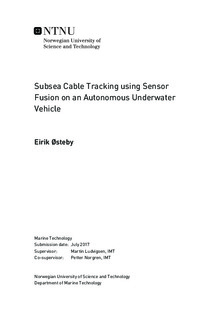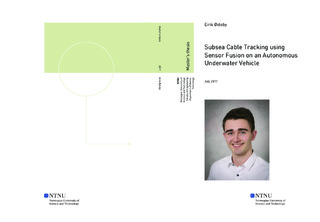| dc.description.abstract | Surveys of underwater power cables by Remotely Operated Vehicles (ROVs) are time demanding and expensive. We want to examine the possibility of using an Autonomous Underwater Vehicle (AUV) with magnetometers for estimating the cable position and autonomously track it, given some prior information of the trajectory. Using AUVs could potentially reduce the duration of the operation significantly, reduce the personnel required, and in the future, remove the dependency on ships throughout the operation.
This thesis proposes a cable detection algorithm that utilize the side scan sonar (SSS) which is already installed on the NTNU REMUS 100 AUV. A Multi-Rate Extended Kalman Filter (MR-EKF) with a cable model is used to combine cable position estimates from magnetometers, SSS and prior information. The estimates are then used to calculate a line-of-sight (LOS) heading for cable tracking.
The results show how the cable detection algorithm is able to successfully find several cables with SSS data from sea trials in Trondheim Fjord, Norway. The simulations also show how the REMUS 100 can be used to track relatively thin cables with only the SSS or in combination with other sensors and a priori data using the MR-EKF. The current solution is set up for detection and tracking of a single cable and should therefore be modified if there are multiple cables in close range. The cable model in the filter enables the AUV to estimate the cable cross-track error in periods with missing measurements, assuming that the cable heading is constant. The cable detection algorithm manages to process the SSS image in a matter of milliseconds which indicates that it can be used for online tracking although this was not tested.
Cable detection with magnetometers is already used by Statnett SF with ROVs since their submarine cables are mostly buried. However, if the cables are not completely buried the SSS solution can be very helpful. This is especially true in areas where the cables create complex magnetic fields or when twisted three-phase cables cancel out the magnetic field. Combining multiple sensors and prior information in the MR-EKF will therefore make an AUV capable of handling challenging tasks and perform the surveys more efficient than with ROVs. | |

